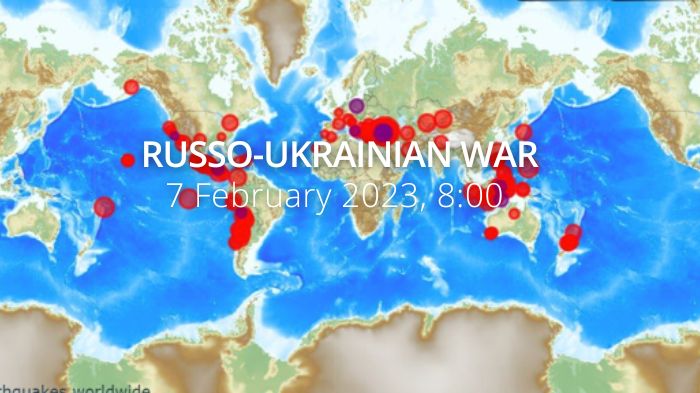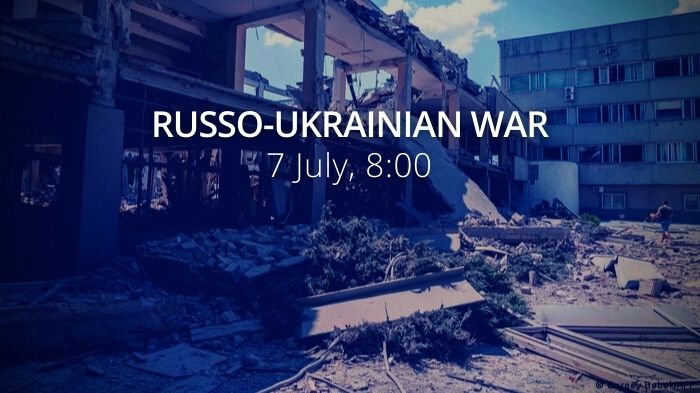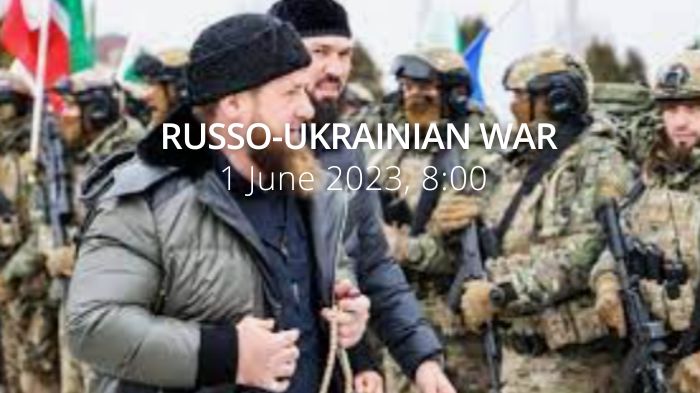In Türkiye and Syria, more than 4200 dead after a powerful earthquake; Ukraine to send rescuers. Within 10 days, Russia plans to launch a new large-scale offensive. Fighting in Donbas continues.
https://twitter.com/ukraine_world/status/1622702094577815554
https://twitter.com/ZelenskyyUa/status/1622482950456504320
Daily overview — Summary report, February 7
A map of the approximate situation on the ground in Ukraine as of 00:00 UTC 07/02/23.
There have been no notable changes to control since the last update. pic.twitter.com/bJwcLmHTbM
— War Mapper (@War_Mapper) February 7, 2023
The General Staff’s operational update regarding the Russian invasion as of 18.00 pm, February 7, 2023 is in the dropdown menu below:
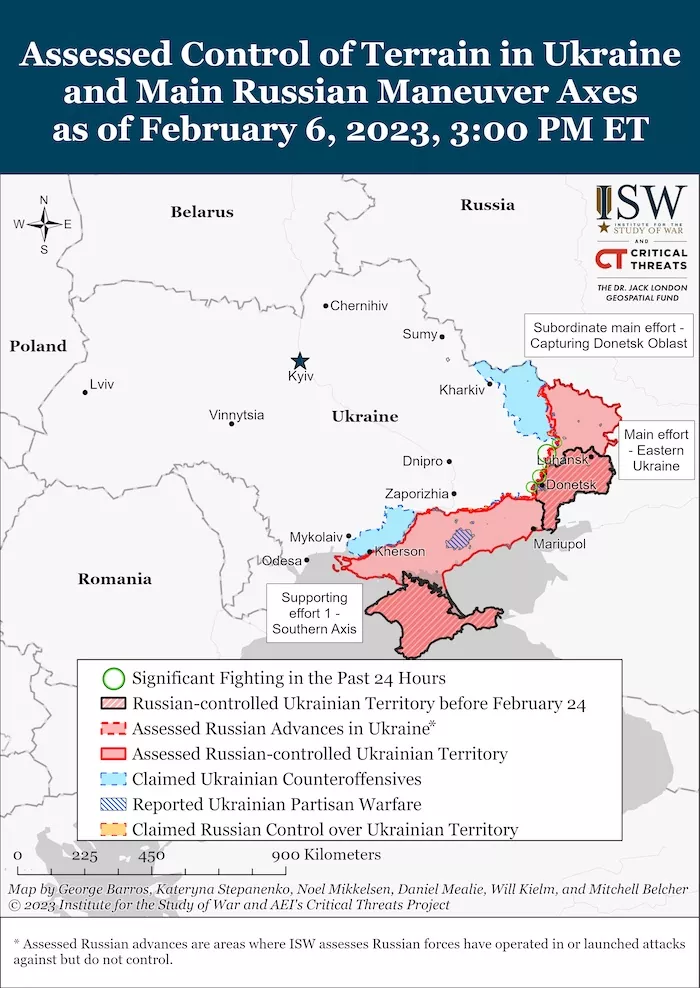
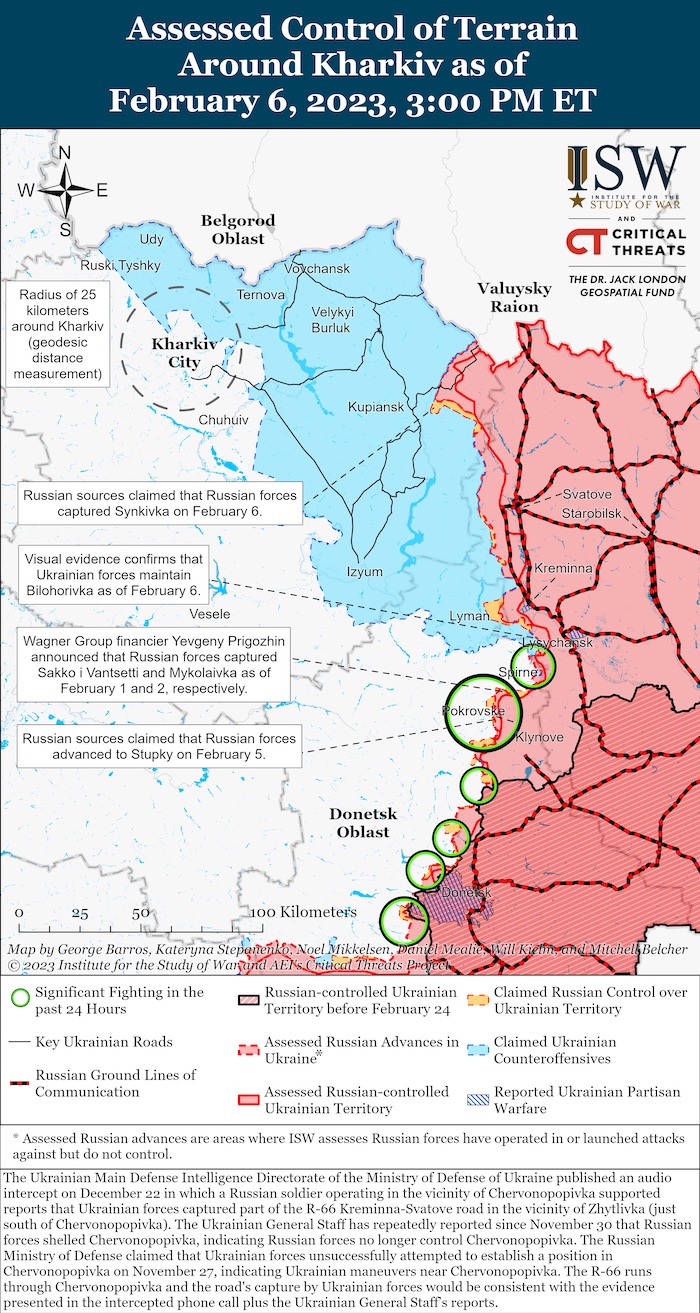
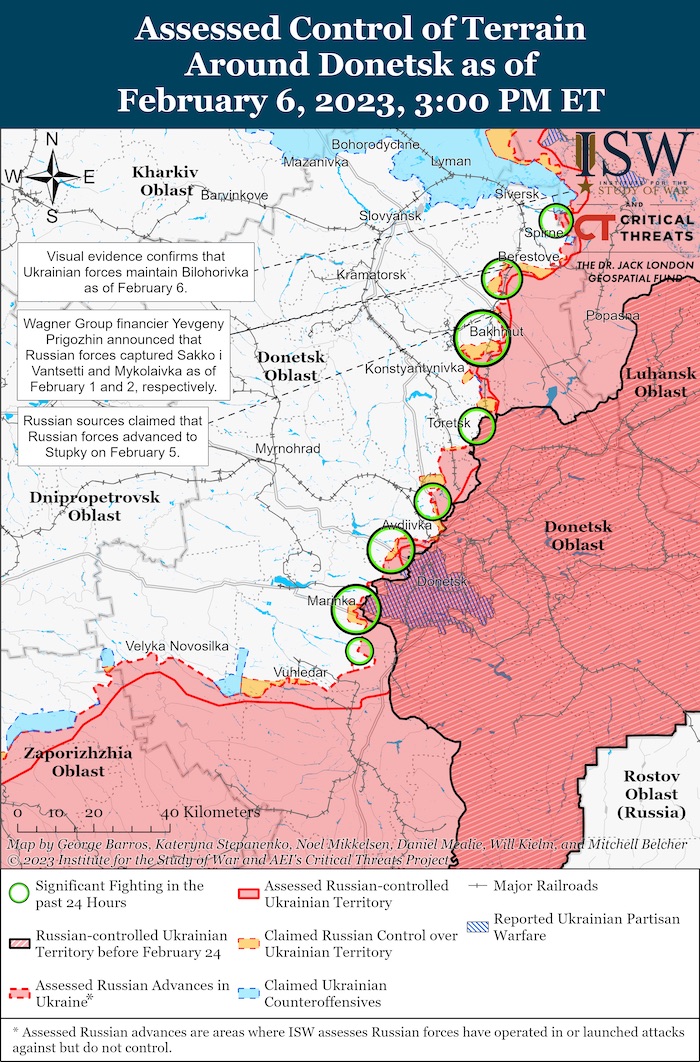
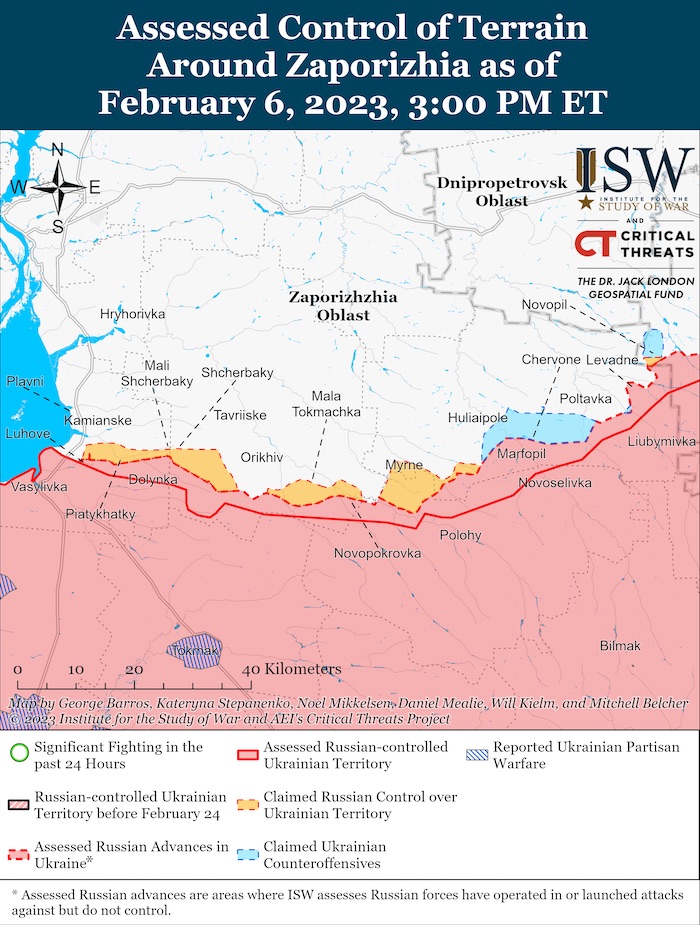
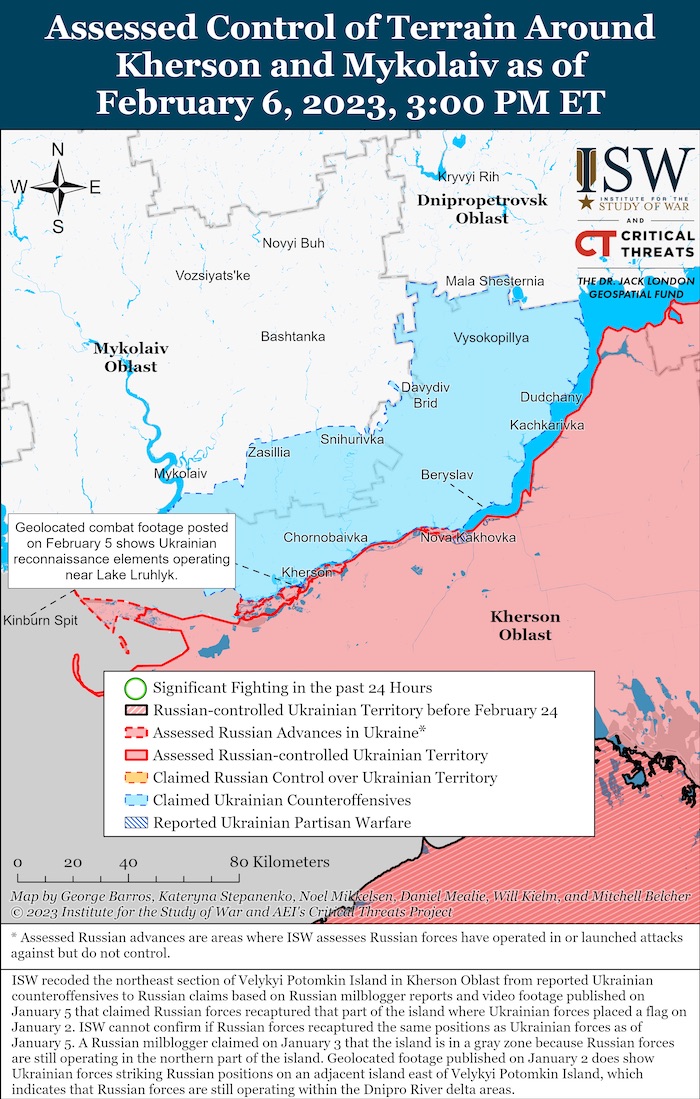
Military Updates
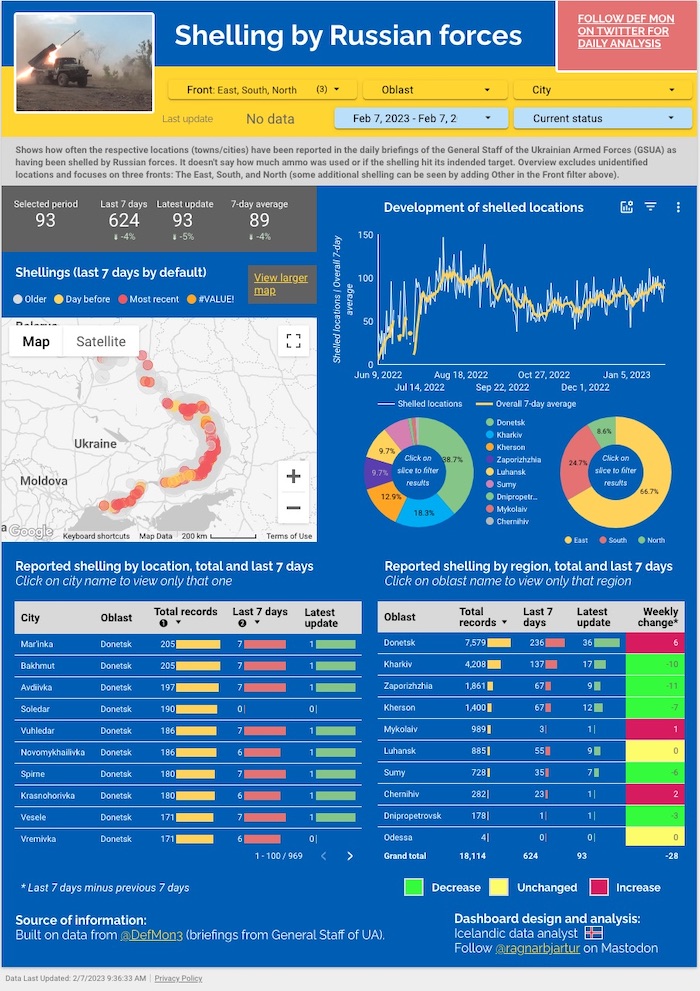
Luhansk Oblast Head Serhii Haidai refuted claims circulated by various Russian sources that the Russian troops have allegedly captured the settlement of Bilohorivka in Luhansk Oblasthttps://t.co/6ts57YYyzk
— Euromaidan Press (@EuromaidanPress) February 5, 2023
Thousands of volunteers applied to Ukraine’s offensive brigades on the first day of the call. “Offensive Guard” assault brigades, which were initiated by the Minister of Internal Affairs Denys Monastyrskyi before his tragic death, immediately attracted the interest of thousands of volunteers; their recruitment continues, Adviser to the Minister of Internal Affairs of Ukraine Rostyslav Smirnov wrote on Facebook. Update: in total, 7,188 volunteers have applied to join the ranks of the Ukrainian “Offensive Guard” units since 2 February when the call started, Censor.net reported referring to the press service of the “Offensive Guard.”
Within 10 days, Russia plans to launch a new large-scale offensive – media. Within the next 10 days, Russia plans to launch a new large-scale offensive, Financial Times writes with reference to an unnamed adviser to the Armed Forces of Ukraine. According to the FT, Ukraine received “very reliable intelligence” about the intention of the Russian Federation to launch a new offensive.
According to British Defence Intelligence, (last 48 hours):
- It is highly likely that Russia has been attempting to re-start major offensive operations in Ukraine since early January 2023. Its operational goal is almost certainly to capture the remaining Ukrainian-held parts of Donetsk Oblast.
- Russian forces have only managed to gain several hundred metres of territory per week. This is almost certainly because Russia now lacks the munitions and manoeuvre units required for successful offensives. Senior commanders likely make plans requiring undermanned, inexperienced units to achieve unrealistic objectives due to political and professional pressure.
- Russian leaders will likely continue to demand sweeping advances. It remains unlikely that Russia can build up the forces needed to substantially affect the outcome of the war within the coming weeks.
Losses of the Russian army
Humanitarian
Russian military burn Ukrainian books in boiler houses on occupied territories. Cases of mass burning of Ukrainian books by the Russian occupiers were recorded in the city of Rovenky, Luhansk Oblast, Ukraine’s Center of National Resistance writes. “In the temporarily occupied territories, the Russians seize Ukrainian books and burn them in boiler houses. Books are seized from general funds and school libraries. In Rovenky, Luhansk Oblast, cases of mass burning of Ukrainian literature in local boiler houses have been recorded.”
Ukraine to send several dozen rescuers to Türkiye to help clear the rubble after the earthquake. The head of the Ukrainian Foreign Ministry Kuleba: “We never do anything that harms the interests of Ukraine. Therefore, such a number, several dozen, Ukrainian rescuers will be able to help Türkiye, our neighbor, our friend, without harming the ability of the rescue services in Ukraine.” On the evening of February 6, Ukrainians gathered near the Turkish embassy in Kyiv to commemorate the victims of the earthquake that occurred today. Ukrainians brought flowers and lighted candles to the embassy.
Environmental
https://twitter.com/EuromaidanPress/status/1622608769107521537
Zelensky announces sanctions on Russian nuclear industry. Zelenskyy announced imposing new sanctions on the Russian nuclear industry as the country continues to repel the Kremlin’s aggression. “Today we have another sanctions step by our country against the terrorist state. The NSDC decision on sanctions against Russia’s nuclear industry has been put into effect,” the Ukrainian leader said. This will not be the last decision of Ukraine to impose restrictions on the Russian nuclear industry for shelling nuclear power plants, using NPPs as a cover for shelling, and threatening other countries’ sovereignty.
Legal
Ukraine’s Anti-Corruption Court transfers $50 million-worth titanium mining facilities from Russian oligarch to the state
Michail Shelkov was accused of tax evasion and export of titanium-containing raw materials to Russia and Belarus in 2020-2021. https://t.co/mGxMQp7pzB pic.twitter.com/gZH4NfaFk7
— Euromaidan Press (@EuromaidanPress) February 6, 2023
Ukraine’s Anti-Corruption Court transfers millions worth of mining facilities from a Russian oligarch to the state. By the decision of Ukraine’s Higher Anti-Corruption Court, all assets of the Demurinsky Mining and Processing Plant were transferred to the state. Russian oligarch Michail Shelkov lost 100% of shares, movable and immovable property of the enterprise, and money in the accounts. In total, the property is worth UAH 2 billion ($50 million). This is not the first such case. Earlier, Michail Shelkov lost his flat and other enterprises specializing in the mining of titanium in Ukraine.
Russia plans to legalize seizure of part of Ukraine by holding pseudo-elections – British intel. On 01 February 2023, Russian Federation Council chair Valentyna Matviyenko said that regional elections will take place in the newly occupied areas of Ukraine on 10 September 2023, British Ministry of Defence reports. “Incorporating the elections into same day of voting which is scheduled across Russia highlights the leadership’s ambition to present the areas as integral parts of Russia. This follows continued efforts to ‘Russify’ the occupied areas, which include revision of the education, communication, and transport systems. While meaningful democratic choices are no longer available to voters at even regional level elections in Russia, leaders will likely make the self-vindicating argument that new elections further justify the occupation,” the reports says.
Ukraine to adopt new transparency laws to fight corruption in Defense Ministry. On 5 February, Ukrainska Pravda citing its own sources reported that the Minister of Defense Oleksii Reznikov, involved in a food procurement scandal, would likely be fired this week. In January, Ukrainian journalists of ZN.ua reported that the Defense Ministry had allegedly purchased products for the Ukrainian Army at inflated prices through a “gasket” company. The media outlet claimed that eggs were purchased at a 2.5 times higher price than current supermarket prices in Ukraine, potato procurement prices were 2.6 times higher, and other products were on average 1.4 times costlier.
Support
https://twitter.com/EuromaidanPress/status/1622691348338905096
Norway plans to provide USD 7 bln in aid to Ukraine over five years. Norway’s prime minister has proposed that his country should provide $7.3 billion in aid to Ukraine over five years, Reuters reported. The largest assistance program Norway has ever had will fund military needs and humanitarian aid, Jonas Gahr Stoere said. The money would be distributed according to the Ukrainian government’s priorities and not necessarily transferred directly to the authorities to avoid corruption.
Ukrainian soldiers arrive in the UK for AS90 training
"The AS90 is an armored self-propelled artillery weapon which the UK is providing to help Ukraine defend its homeland and retake territory,” @DefenceHQ saidhttps://t.co/huk13SLrQA pic.twitter.com/ERQAayo2Oe
— Euromaidan Press (@EuromaidanPress) February 6, 2023
Ukrainian soldiers arrive in the UK for AS90 training. Ukrainian soldiers have arrived in the UK for military training on AS90 howitzers, the British Ministry of Defence says. “A warm welcome to Ukrainian personnel who have arrived in the UK this weekend to get to grips with the AS90. The AS90 is an armored self-propelled artillery weapon which the UK is providing to help Ukraine defend its homeland and retake territory,” the ministry said on Twitter.
"Everyone can help Ukraine win"
Estonian PM for a day joined the volunteers who make trench candles for Ukrainian soldiers https://t.co/QbirCWZeFA
— Euromaidan Press (@EuromaidanPress) February 6, 2023
New Developments
How to Help Earthquake Victims in Turkey and Syria – The New York Times https://t.co/41NTtIhHVj
— Rachel Maddow MSNBC (@maddow) February 7, 2023
According to updated data, in Türkiye, the tragedy claimed the lives of 2,921 people, 15,800 were injured. In Syria, the death toll is 1,293, more than 3,000 were injured. Earthquakes of varying magnitude were also recorded in Northern California, the United States, Panama, Italy, Indonesia, El Salvador, Chile, and even Poland.
https://twitter.com/EuromaidanPress/status/1622679017257320448
Ukrainian intelligence says Russia is waiting for new batch of Iranian Shahed drones. Russia will receive a new batch of Shahed drones from Iran. So far, the invaders have used about 660 drones out of 1,750 to exhaust Ukraine’s air defense system, said Vadym Skibitskyi, a representative of the Defense Intelligence of Ukraine. “According to our data, they will have another delivery soon – we will specify the number of drones later,” he added.
Historical decision: Ukrainian Greek Catholics to mark Christmas on 25 December in a symbolic break with Russia. A reform of the Church calendar in Ukraine was announced by Sviatoslav Shevchuk, leader of Ukraine’s second-largest church, the Greek-Catholic Church: it will transition from the Julian calendar to the Revised Julian Calendar in a symbolic break with Moscow. This means it will celebrate Christmas and other immobile feasts on 25 December like most of the world’s Christians, but Easter according to the Julian calendar.
German Minister of Education has arrived in Kyiv. German Minister of Education Bettina Stark-Watzinger has arrived in Kyiv to meet with Ukrainian counterpart Serhiy Shkarlet and Ukrainian scientists. She will discuss further support with Ukrainian partners, including education for Ukrainian refugees in Germany. Reportedly, she will also visit the building of Ukraine’s Ministry of Education that was damaged by a Russian missile attack.
Assessment
- On the war.
The Institute for the Study of War has made the following assessment as of February 6, 2022:
Ukrainian officials assess that Russian forces are preparing to launch a large-scale decisive offensive in eastern Ukraine in mid-to-late February. Ukrainian Defense Minister Oleksiy Reznikov stated on February 5 that the Ukrainian military is expecting Russia to start its decisive offensive around February 24 to symbolically tie the attack to the first anniversary of the Russian full-scale invasion of Ukraine.[1] Reznikov also clarified that the Ukrainian military has not observed the formation of Russian offensive groups in the Kharkiv and Chernihiv directions or Belarus; Ukrainian Southern Operational Command Spokesperson Nataliya Humenyuk noted that Russian forces are likely concentrating on launching offensive operations in the east rather than in southern Ukraine.[2] An unnamed advisor to the Ukrainian military told Financial Times that Russia intends to launch an offensive in the next 10 days (by February 15), a timeline that would allow Russian forces to strike Ukrainian positions before the arrival of Western tanks and infantry fighting vehicles.[3] Luhansk Oblast Administration Head Serhiy Haidai stated that Russian forces are continuing to deploy reserves to Luhansk Oblast to strike after February 15.[4]
Select Russian nationalist voices continued to express skepticism towards Russia’s ability to launch a successful offensive past late February. A Wagner-affiliated milblogger noted that Chief of the Russian General Staff Army General Valery Gerasimov (who currently commands Russian forces in Ukraine) has a limited time window to launch a large-scale offensive operation in Ukraine before it is entirely impossible to execute.[5] Another ultra-nationalist voice, former Russian officer Igor Girkin, forecasted that the Russian decisive offensive will not be successful until Russia mobilizes more manpower, industry, and economy.[6] Girkin claimed that an attack without such mobilization would shortly culminate. Both observations highlight that the Russian military command appears to be in a rush to launch the decisive offensive, likely ahead of the arrival of Western military aid and the muddy spring season in Ukraine around April that hindered Russian mechanized maneuvers in spring 2022.
German Chancellor Olaf Scholz undermined Russian President Vladimir Putin’s false narrative that the provision of German tanks to Ukraine threatens Russian security. Putin stated on February 2 that German tanks are again threatening Russia, drawing a false parallel with World War II.[7] Scholz stated that Putin’s remarks are “a part of a series of abstruse historical comparisons that he uses to justify his attack on Ukraine.”[8] Scholz added that the West and Ukraine have a “consensus” that Ukrainian forces will only use Western-provided weapons to liberate its territories from Russian occupation. Germany’s provision of Leopard tanks does not differ from Western military provisions of Soviet tanks and kit to Ukraine throughout the war, and Putin’s February 2 reaction is likely a continuation of Russian information operation to discourage Western military aid to Ukraine ahead of Russia’s decisive offensive. Kremlin information agents are amplifying similar rhetoric that Ukrainian forces will use Ground Launched Small Diameter Bombs (GLSDM) – which increase the range of HIMARS to 151km from roughly 80km – to target Russian territory alongside occupied Ukrainian territories.[9] Ukrainian Defense Minister Oleksiy Reznikov confirmed on February 5 that Ukraine agreed to not use Western long-range weapons to strike Russian territories, however.[10]
Kremlin-appointed Russian and occupation officials continue to implement social benefit schemes that target children and teenagers in occupied areas of Ukraine to consolidate social control and integration of these territories into Russia. Russian Commissioner on Children’s Rights, Maria Lvova-Belova (appointed by Russian President Vladimir Putin) met with a slate of Russian occupation officials on February 6 to discuss various issues relating to children and youth in occupied regions of Ukraine. In a meeting with occupation head of Crimea Sergey Aksyonov, Lvova-Belova noted that the Crimean occupation government has been instrumental in “accepting” children from Donetsk, Luhansk, Zaporizhzhia, and Kherson oblasts.[11] Lvova-Belova also reported that the “Day After Tomorrow” organization will begin conducting “rehabilitation” tours in Crimea to work with children who need special psychological assistance.[12] ISW has previously reported on numerous instances of Russian occupation officials using the guise of psychiatric and medical rehabilitation to remove Ukrainian children further into Russian-controlled territory within Ukraine or deport them to Russia.[13] Sevastopol occupation head Mikhail Razvozhaev similarly announced that he met with Lvova Belova on February 6 to discuss “new formats of social work” on behalf of Putin and remarked that most of the children who require social support are not orphans.[14] Luhansk People’s Republic (LNR) Head Leonid Pasechnik stated that Lvova-Belova proposed that children whose personal data is in the regional data bank will be “able to find a family in other regions of the Russian Federation.”[15] Pasechnik also reported that LNR authorities are working with Novosibirsk Oblast and Khanty-Mansi Okrug to secure “methodological assistance” in resolving issues regarding children in occupied Luhansk Oblast.[16] Lvova-Belova additionally met with Donetsk People’s Republic (DNR) Head Denis Pushilin to develop programs “for the socialization of adolescents” and with Zaporizhzhia occupation head Yevgeny Balitsky to discuss social institutions for children in occupied Zaporizhzhia Oblast.[17]
Lvova-Belova is likely working directly on Putin’s orders to institute several social institutions and programs in occupied areas of Ukraine to collect personal data on children, carry out various social programming functions aimed at integrating occupied areas using pseudo-humanitarian organizations, and set conditions to legitimize and institutionalize the deportation and adoption of Ukrainian children into Russian families. Putin signed a list of instructions on January 3 that directed Lvova-Belova and directed the occupation heads of Kherson, Zaporizhzhia, Donetsk, and Luhansk oblasts to “take additional measures to identify minors…left without parental care” in occupied areas to provide them with “state social assistance” and “social support.”[18] Lvova-Belova’s February 6 meetings with occupation heads are likely the manifestation of Putin’s list of instructions and represent an escalation in efforts by Kremlin-appointed officials to consolidate social integration of occupied territories by targeting children.[19] The implementation of “rehabilitation centers” and the tabulation of children’s personal data through these social programs will likely enable Russian occupation officials to facilitate the forced deportation and adoption of Ukrainian children to Russian families. Occupation officials continue to execute social control measures in occupied areas according to directives provided by Putin’s list of instructions. ISW continues to observe that efforts to deport and forcibly adopt Ukrainian children may constitute a violation of the Convention on the Prevention and Punishment of the Crime of Genocide.[20]
Russian President Vladimir Putin continues to open the door for further institutionalized corruption in Russia through legislative manipulations. Putin signed a decree on February 6 allowing Russian deputies and senators to not publish their incomes in the public domain.[21] The law will allow deputies and senators to publish their incomes in an anonymized form that does not contain their personal data. The law will also apply to regional and municipal deputies.[22] Kremlin spokesperson Dmitry Peskov claimed that the new law will not affect anti-corruption measures and stated that “the conditions of the [special military operation] bring their own specifics.”[23] Putin previously approved a decree on December 29, 2022, that exempted all Russian officials, including members of the military and law enforcement, from making public income declarations.[24] These two decrees are likely efforts by the Kremlin to appease the political actors who comprise Putin’s domestic support base and will likely continue to contribute to the institutionalization of corruption in Russia.
The Kremlin continues to deny Wagner Group financier Yevgeny Prigozhin legitimacy and authority in Russia. A Moscow court refused to recognize Prigozhin as the owner and founder of Wagner private military company (PMC) after revisiting Prigozhin’s lawsuit against Russian journalist Alexei Venediktov on February 6.[25] Prigozhin sued Venediktov in June 2021 for accusing him of being the “owner of Wagner,” and the Moscow court concluded that information about Prigozhin’s ownership of Wagner was “unreliable.”[26] Prigozhin attempted to reverse the court’s decision on January 19, claiming that Venediktov did not lie about Prigozhin’s ownership of Wagner—likely in an ongoing effort to overcompensate for his declining influence following the replacement of war-torn Wagner forces around Bakhmut with Russian conventional units.[27] ISW previously assessed that the Russian military’s decreasing reliance on Wagner forces around Bakhmut is likely reducing Prigozhin’s influence within the Kremlin inner circle.[28]
Prigozhin’s appeal in the Russian nationalist information space may also be declining as he continues to overcompensate for the culmination of Wagner’s attack around Bakhmut. A prominent Kremlin-affiliated milblogger commented on a video showing Prigozhin piloting an Su-24M bomber aircraft supposedly over Bakhmut on February 6.[29] The milblogger stated that Prigozhin became the main player in Russian information space rather than the traditional Russian military command which “lacked creativity.”[30] Prigozhin also “declared” the US, UK, and Canadian governments to be illegitimate states that sponsor terrorism according to the “Wagner Charter.”[31] The milblogger stated that Prigozhin’s manipulation of the information space – specifically his skill in trolling – had allowed him to gain more political influence than a Russian Defense Minister.[32] ISW assessed on October 25 that Prigozhin weaponized the Russian information space and Russian President Vladimir Putin’s reliance on his forces to gain political leverage in Russia.[33] The milblogger’s acknowledgment of Prigozhin’s flashy tactics may indicate that the non-Wagner-affiliated nationalist information space may be awakening to Prigozhin’s efforts to use the war in Ukraine for personal benefit. Wagner-affiliated milbloggers, in turn, continued to celebrate Prigozhin and previous theater commander Army General Sergey Surovikin as the only two leaders who have “confirmed their high qualifications and enjoy the trust of the political leadership of the country and the people.”[34]
Failures of Western sanctions efforts against the provision of arms components to Iran have likely contributed to Russia’s ability to bypass Western sanctions to acquire components for combat drones through military cooperation with Iran. US officials stated on February 5 that Russia and Iran are moving ahead with plans to build an Iranian drone factory on Russian soil, the second such international Iranian drone factory.[35] Iran opened a drone production factory in Tajikistan – a Collective Security Treaty Organization (CSTO) member state and Eurasian Economic Union (EAEU) candidate – in May 2022.[36] Russia may leverage its significant economic ties to Tajikistan through the CSTO and EAEU to launder drone components or procure manufactured drones for use in Ukraine to bypass international sanctions.[37]
UK investigative group Conflict Armament Research (CAR) reported in November 2022 that 82% of Iranian Shahed-131, Shahed 136, and Mohajer-6 drones downed in Ukraine had chips, semiconductors, and other components that came from the US despite high import and export control restrictions on such components to Iran.[38] CAR also noted that the downed drones contained higher-end technological capabilities and have a “significant jump in capabilities” compared to other systems previously observed in the Middle East.[39] Most Western-manufactured components in the downed Iranian drones were produced between 2020 and 2021, following the expiration of United Nations Security Council heavy arms sanctions against Iran in 2020.[40] Most Western companies whose components were found in downed Iranian drones in Ukraine denied directly selling components to Russia, Iran, or Belarus since the start of the war.[41] However, the representative of a Swiss manufacturing company noted that it is impossible to be completely sure that distributors of arms components do not sell components to sanctioned entities, implying that Russia, Iran, or other sanctioned states can exploit loopholes allowing them to acquire Western-produced arms components via proxy actors.[42]
Key Takeaways
- Ukrainian officials assess that Russian forces are preparing to launch a large-scale decisive offensive in eastern Ukraine in mid-to-late February.
- Select Russian nationalist voices continued to express skepticism toward Russia’s ability to launch a successful offensive past late February.
- German Chancellor Olaf Scholz undermined Russian President Vladimir Putin’s false narrative that the provision of German tanks to Ukraine threatens Russian security.
- Kremlin-appointed Russian and occupation officials continue to implement social benefit schemes that target children and teenagers in occupied areas of Ukraine to consolidate social control and integration of these territories into Russia.
- Russian President Vladimir Putin continues to open the door for further institutionalized corruption in Russia through legislative manipulations.
- The Kremlin continues to deny Wagner Group financier Yevgeny Prigozhin legitimacy and authority in Russia.
- Prigozhin’s appeal in the Russian nationalist information space may also be declining as he continues to overcompensate for the culmination of Wagner’s attack around Bakhmut.
- Failures of Western sanctions efforts against the provision of arms components to Iran have likely contributed to Russia’s ability to bypass Western sanctions to acquire combat drones through military cooperation with Iran.
- Russian forces likely made tactical gains northeast of Kupiansk between February 4 and February 6, and Russian sources claimed that Russian forces advanced west of previous positions on the Svatove-Kreminna line on February 5 and February 6.
- Ukrainian forces maintain positions in Bilohorivka in Luhansk Oblast as of February 6 despite Russian claims that Russian forces captured Bilohorivka on February 3.
- Russian forces continued ground attacks northeast and south of Bakhmut but still have not encircled the settlement as of February 6.
- Russian forces conducted limited ground attacks in the Avdiivka-Donetsk City area.
- Ukrainian forces continued limited attempts to cross the Dnipro River.
- Russian conventional and irregular forces may be increasingly struggling to recruit from Russian penal colonies due to high casualties among prior penal colony recruits.
- Russian forces continue to struggle with ethnic tensions and tensions between irregular forces.
- Russian officials and occupation authorities may be intensifying operational security to conceal new Russian force deployments in Donbas.




